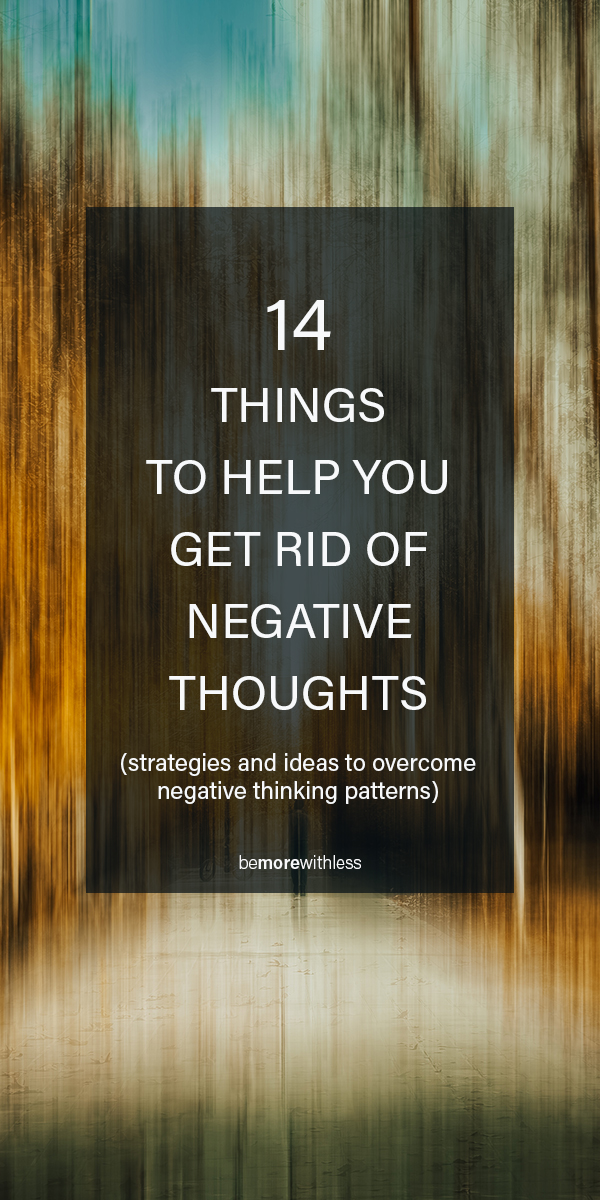I’m guessing this isn’t the first time you’ve wondered how to get rid of negative thoughts. I hope these recommendations are more helpful than what you’ve come across before.
For most of my life, I’ve struggled with negative thoughts. These thoughts have come up around work, relationships, and my health. I’ve tried stopping negative thoughts from entering my mind. But stopping negative thoughts hasn’t worked for me.
Instead, I learned how to reframe the stories I told myself. To do this, I found support through therapy, books, and long conversations with friends. These reframing strategies improved my mental health and happiness.
In this article, I’ll review some of the tools and actions that have helped me identify and overcome negative thoughts. It’s important to note that the topics below are an overview of my perspective and personal experiences and learnings. If you need extra support, please consider talking to a mental health professional.
Why are negative thoughts so harmful?
Research suggests that negative thoughts can contribute to depression, anxiety, stress, unhealthy habits and low self-esteem. For example, negative thoughts have impacted my:
- mental and physical health
- thought processes
- work life
- and ability to finish creative projects.
Arlin Cuncic, a writer with Verywell Mind, defines negative thoughts as, “negative beliefs you might have about yourself, situations, or others. They can affect your mood and can be present in certain mental health conditions.”
Below are examples of negative thoughts that I’ve struggled with in the past:
- My writing will never be good enough.
- My clients will think I’m stupid.
- My business is destined to fail.
These types of negative thoughts still pop into my mind. However, I’m able to recognize and reframe my thoughts much more quickly.

14 Ways to Get Rid of Negative Thoughts
Reframing negative thoughts is a practice, it takes time, and I constantly ask for help. Below you’ll find 13 tips I use to cope with negative thought patterns.
If you’re struggling with negative thoughts, pick a few tips that you can use in your daily life. Some of the tips might not interest you, and that’s okay!
Tip #1: Therapy
Over the years, I’ve seen numerous therapists. They have helped me by listening to my stories. They’ve also recommended tools like journaling and meditation; I use both daily. Following their advice has helped me reframe negative thought patterns.
If you’re thinking about seeing a therapist, do some research. A good starting point is to ask a trusted friend or your doctor for a referral.
Tip #2: Journaling
There are many benefits to starting a journaling practice. Journaling is a key part of my daily routine. I also use journaling prompts throughout the day; especially when I struggle with negative thinking.
For example, when I wrote this article, I struggled with negative thoughts. So, I stopped writing the article, opened my journal, and responded to Byron Katie’s Four Questions.
Katie’s prompts include:
- Is it true?
- Can you absolutely know that it’s true?
- How do you react, what happens, when you believe that thought?
- Who would you be without that thought?
Learn more about Katie’s work.
Tip #3: Be Kind to Yourself
When I was in my early twenties, the idea of “being kind to myself” seemed cheesy and unhelpful. I was wrong. When I struggle, I pause, take note, and write about what’s happening. Also, I ask myself: What would you tell your best friend?
When a good friend is struggling with a problem, I try to listen and offer encouraging words or resources. I do that with myself, too! It sounds cheesy, but the practice has made my life so much better. I am worth being kind to and doing so helps me to recover from negative thoughts more easily and enjoy my life more.
Tip #4: Go on a “Noticing Workout”
Recently, I discovered Bill Keaggy’s TEDTalk. It’s about finding “attention, mindfulness, and creativity in the ordinary.” In his talk, Keaggy mentions an activity called the “30-minute noticing workout.” The workout involves walking, paying attention, and taking photos. I love this activity! It’s amazing how moving my body, and turning my attention outward through photography, can reduce the negative chatter in my mind.
Tip #5: Write Gratitude Lists
Writing gratitude lists is another way that I reframe negative thoughts. This isn’t about denying negative emotions. It’s important to notice and acknowledge hard experiences and feelings. It’s equally important to record the good things in my life; especially when I’m having a tough day.
Tip #6: Meditate
Meditating helps me rest. It’s also an opportunity to notice the thoughts that come up. When I meditate, the thoughts can be positive or negative. I’ve learned to simply notice the thoughts that arise; especially the negative thoughts. It’s helped me realize that thinking a thought doesn’t mean it’s true.
Tip #7: Volunteer
I’m in the process of going through a training program to volunteer at our local hospital. I’m excited about the opportunity because volunteering is a way to give back to my community. It’s also a way to help myself. When I’m helping others, I don’t have time to focus on negative thoughts.
Tip #8: Make a Friend Date
Tending to my relationships is the key to living a happy and healthy life. For instance, I go on weekly dates with my friends. Our meet-ups make me happy. Plus, I can lean on my friends when I’m dealing with negative thought patterns. They listen, and usually offer advice or tips that are helpful. Friends will share their struggles with me, too. In turn, I can listen and offer advice.
I prioritize my long-distance friendships too by scheduling regular phone calls, sending care packages and postcards and remembering that there are people on my side all over the world.
Tip #9: Work on a Creative Project
I have a list of hobbies and projects that I’m working on in my journal. When I’m stuck in a cycle of negative thinking, I open my journal and look at this list. This helps me shift my attention toward creativity, instead of negative thoughts. It’s a good reminder that my creative projects are fun, and offer me the opportunity to learn, explore, and grow.
Tip #10: Laugh and Learn
A few days ago, my writing felt stale and my negative thoughts were getting the best of me. So, I turned on my favorite podcast, Maintenance Phase, and went for a walk. The podcast hosts debunk serious subjects, and they are funny. Learning and laughing helped me break a cycle of rumination, and get back to writing.
Tip #11: Have a Snack
Being immersed in a project is fun. I love being in a state of flow! However, it can be a problem because I forget to eat. If I don’t eat, I get hungry. And for me, being overly hungry can lead to negative thinking. I’ve learned the hard way to build snack breaks into my work routine. Cookies are my favorite food to nibble on. A hot chocolate with whipped cream and marshmallows on top will work, too. If I don’t have a sweet on hand, a colorful fruit also seems to work.
Tip #12: Move Your Body
You can move your body anytime but it’s especially powerful when you are experiencing symptoms from your negative thoughts. When it comes to overcoming negative thinking it’s more about acceptance to prevent worries or spirals. Try yoga, walking or other physical exercise. It can serve as a distraction by removing you (at least short term) from your negative thoughts. Physical movement can impact stress hormones like cortisol, endorphins and emotional reasoning.
According to this article from Harvard Medical School, “Exercise reduces levels of the body’s stress hormones, such as adrenaline and cortisol. It also stimulates the production of endorphins, chemicals in the brain that are the body’s natural painkillers and mood elevators.”
Tip #13: Assess Your Sleep Patterns
When I don’t get enough sleep, I’m grouchy, anxious, and prone to feeling sad. So, I follow a firm sleep schedule. I go to bed around 8.30pm and wake up at 6am; sometimes earlier. This works for my personality and work routine. Also, a few hours before bed, I put my smartphone to bed. Reading a book helps me unwind and sleep better.
Tip #14: Quit Social Media
About three years ago, I quit using social media. I don’t regret my decision. Not using social media has helped me slow down, and it’s improved my mental health. Plus, I have more time to spend with friends, and I’m less likely to compare myself to others.
Looking for inspiration to spend less time on your phone? Listen to Lulu Garcia-Navarro’s interview with Logan Lane; a teenager who gave up her smartphone. In the conversation, Lane talked about how social media negatively impacted her thoughts. Also, Lane started the “Luddite Club;” a club of “teenagers who reject technology and its creeping hold on all our lives.” I’m inspired by Logan Lane and her friends! Here are more suggestions to spend less time on your phone.

Reframing Negative Thoughts: It’s a Practice.
Learning to reframe negative thoughts is a practice. Over the years, I’ve learned to make the practice joyful by asking for help. And, I continue to seek out resources that support and inspire me.
If you’re looking for resources to get started, here are a few recommendations:
Nothing I’ve shared here is to suggest that you are to blame for your negative feelings or thoughts, or that you should simply prioritize positive thinking. As someone who has struggled with negative thoughts and negative self-talk, I have no judgment whatsoever.
